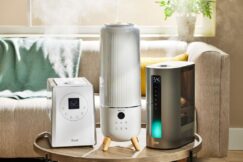The benefits of Humidifiers become apparent as the cold and dry air sidles into the unwary households and we find ourselves reaching out for the blanket or pouring out more moisturizers on ourselves; before we know it, winter is back and the dry air bruises the skin with cracks and impedes breathing- humidifiers become the necessary evil.
‘Necessary evil’ is a fitting tag as humidifiers with the myriad of benefits introduce health risks, if not maintained properly.
How Humidifiers Affect Our Health: The Benefits vs. the Downsides
The Benefits
The benefits of humidifiers circle back to the term itself; these devices improve air quality when the air is rendered dry. Dry air affects our health in many ways: dry skin, dry lips, nasal and sinus complications, throat irritation and so much more. All these can be tackled by improving the air quality of the house, and that’s where humidifiers come in!
Humidifiers, moreover, provide comfort not just during the dry seasons but throughout the air.
Awesome deal, right? But do the benefits of humidifiers really outweigh the downsides? Let’s find out…
The Downsides
Great features demand great care for proper functionality. Humidifiers, if not handled with care, pose health issues.
The issues arise from either the device being dirty or from the humidifier creating excess humidity.
Keep It Clean: Dirty Humidifiers and Health Problems

A dirty humidifier accumulates bacteria or molds if not cleaned regularly or used periodically. Additionally, the type of water used in humidifiers also contributes to uncleanliness. Undistilled or water from the tap contains particles that amass inside the humidifier which naturally find a way back into the air afterward – the air is humid but also dirty! Distilled water is, therefore, strongly endorsed for humidifiers.
The type of humidifier used is also a considerable aspect. Humidifiers are generally two types: the cool mist kind and the warm mist kind. The issue arises with the warm mist type which boils and evaporates water into the air. This technology and mechanism are ancient and are the ideal breeding ground for microbes. As a result, to deal with the downside of warm mist humidifiers, frequent clean-up becomes mandatory and also a chore. The cool mist type utilizes more current technology and therefore is the more beneficial humidifier by a considerable margin.
Also, too much humidity can downplay the benefits of a humidifier. Experts have concluded that the ideal humidity levels of air should be between 30 -50 %. Anything lower or higher than these numbers negatively affects health. High humidity which might stem from humidifiers can cause surge levels of moisture in the air which would escalate the bacterial growth, mold, etc. in the house. High moisture can create allergens which also lead to breathing issues.
Tips on How to Use a Humidifier
On a personal note, the benefits of a humidifier do tend to outweigh the drawbacks if used right. Fortunately using it right isn’t that hard altogether.
Don’t let water sit idle in the tank
Always empty your tank if you are taking a break from using the humidifier for a period of time (ideally if the period is more than a couple of days). Stagnant water invites the growth of bacteria and these bacteria make their way into your system through the air humidified by your device.
Clean it regularly
Clean the tank every 7 days: use an equal mix of white vinegar and water to fill the tank, and then activate the humidifier. Keep it on for an hour, empty the contents of the tank, flush it clean, and finally refill with clean water before running it again for another hour before the next use or before putting it away. Clean tank equals clean air; always opt for distilled water
Change humidifier filters
Consider changing the filters every 1 or 2 months; the duration depends on the degree of usage of the humidifier. A good way to make sure if the filter is not operational is by checking if it’s giving odor, if the filter feels friable to touch, or if the output of humidity is lower than normal.
Prepare humidifiers for storage
Check the manufacturer’s instructions for storage. Primarily all manufacturers recommend cleaning the humidifier parts and drying them before storage. Also, it is also advised to remove the filter unit before storing it.
Keep the area around humidifiers dry
Keep the area around the humidifier clean because dirt or dust is likely to end up in the humidifier and clog it up, or worse, dispel it back to the surroundings in even more grim conditions.
Consider replacing old humidifiers
There are a few things to keep in mind when operating old humidifiers.
- Firstly question: how old is really old? In terms of humidifier lifespan, 10 years is the maximum for a good humidifier to safely function properly. Afterward, the quality of service detriments. Consider a change; the market has a wide range of the latest humidifiers to offer.
- If the premises or dimensions of the service area for the humidifier have changed, the humidifier may require a change too. Too big or too small service area would either result in the inefficiency of the humidifier or in the air of the space becoming too humid.
- Has the humidifier been repaired or diagnosed for service? If it hasn’t been under some repair, consider changing it. If it has and the output isn’t the same as in the past, again, consider changing it!
All these suggestions, tips, and tricks are a good way to ensure that you reap the maximum benefits of your humidifier. A clean and fit humidifier would only make a healthy ‘You’!




